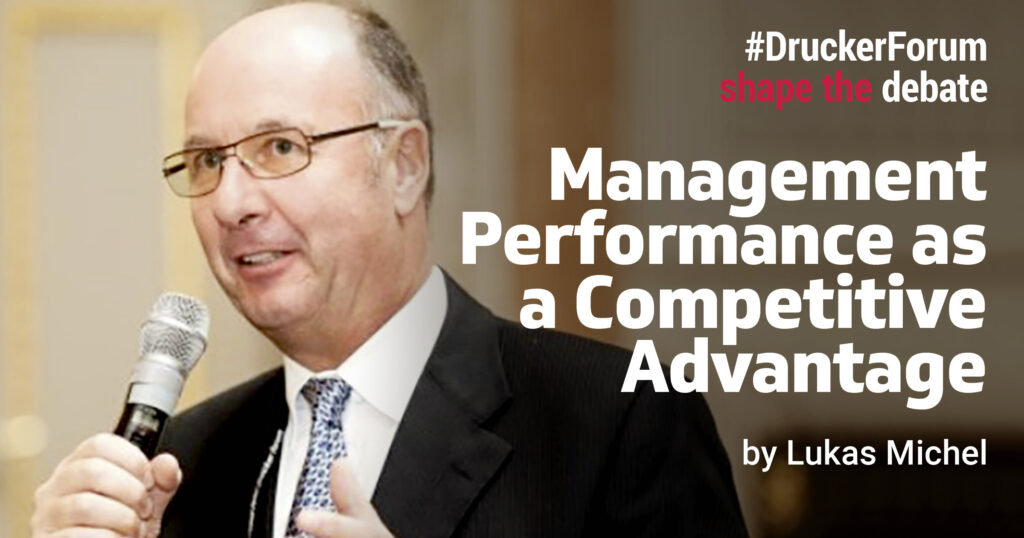
Let’s think of management as the art, science, and craft to get work done. As most of us perform some kind of work, and most work requires more than one individual to complete, we need to care about management. It touches everyone, everywhere, anytime.
Typically, when it comes to performance, discussion centers around employees, context and the culture needed to perform at peak. This attitude reflects traditional management: everybody else, who do the work need to be more efficient, be higher performing – not me.
It’s time we inwardly reflect on the performance of management. But management is like taste. One only notices it when its gone. Nobody wants superior management if everything went well. Superior management is a given. Equally, poor management is always attributed to a poor manager. It’s personalized. That why it makes sense to think about the performance of management itself – the science, the art, the craft.
We know from diagnosing hundreds of organizations world-wide that the problem is not usually with managers. It’s with management. The evidence is mounting that in today’s hyper-dynamic and disruptive business environment, traditional management based on control, change, projects, and engagement has seen better days.
Two trends – digitalization and the changing nature of work – fundamentally alter the way we manage people and organizations. New external challenges and more knowledge with people at the client front expedite the trend. Traditional management cannot cope with a digital context. That opens the conversation about better management as a competitive advantage. Traditional competitive advantages vanish fast in the digital economy. What is left in organizations is management – how work is being done. That leaves organizations with a huge opportunity to turn their management into a competitive advantage.
Competitive advantage has long been the yardstick for success and the performance of management. The diagnostic data from 400 companies of all kinds from around the globe clearly shows a strong relationship between management and outcomes. Better-managed organizations make a difference. They are considerably more agile, people-centric, and ready for a dynamic market environment. And they are better off competing with 21% higher performance, 25% higher innovation, and 28% higher growth.
To be a true differentiator, management needs to fulfil the criteria of a competitive advantage. In line with strategic management professor Jay B Barney’s resource-based view of the firm and the VRIN criteria for competitive advantage (valuable, rare, inimitable and non-substitutable), our research has identified a model with six features to signal whether management qualifies as a competitive advantage. The standards represent steps with increasing demands, greater impact, and higher sustainability:
- A viruses-free, collaborative, connected, and purposeful work environment for people to get work done.
- A strategy with agile capabilities that safeguards performance, innovation, and growth for the organization to create value in a dynamic context.
- People-centric management with principles for self-responsible people who make the client offering specific.
- People who play the inner game to experience flow, which makes performance hard to copy.
- An operating system with dynamic capabilities that prevent short cuts.
- A toolbox with diagnostic systems for interactive leadership that is deeply embedded in culture.

Six questions offer the measurement of management as a competitive advantage:
Does the work environment enable people to get work done? Culture, purpose, relationships, and collaboration size up the work environment. An engaging work environment is a competitive advantage because it enables people to get work done.
Does your organization keep promises and create value? Performance, innovation, growth, and success determines organizational outcomes and reveal whether management creates value. Keeping promises is a competitive advantage because it establishes trust with clients, which is of greatest value.
Does your management create unique value? Review whether management applies a control-based (traditional management) or an enabling-based (people-centric management) approach to leading people. A people-centric management approach is a competitive advantage because it mobilizes resources in ways that make the client offering specific.
Do people use their talent to exceed expectations? Awareness, trust, choice, and focus of attention are the means for people to experience flow, perform at their peak and learn. Achieving flow more often – the state of high performance – is a competitive advantage that is hard to copy.
Is your operating system read for VUCA? Review the operating system to evaluate whether it is designed for a traditional or a dynamic environment. A dynamic operating system is a competitive advantage, as it prevents shortcuts.
Is your toolbox deeply embedded in culture? Do systems and leadership have interactive and diagnostic features? Their usage tells us whether the toolbox is rooted in the culture and is a competitive advantage.
What can you do to reach the standards?
- Work environment: Remove the interference and offer the opportunity.
- Strategy and results: Develop agile capabilities and clear expectations.
- Management: Engage in people-centric principles for people to mobilize their resources.
- People: Enable people to play the inner game for them to unfold their potential.
- Operating System: Insist on dynamic features in support of people to master higher challenges.
- Toolbox: Maintain a diagnostic toolbox for people to capture new opportunities and grow.
With these six features, management turns into a competitive advantage. Companies that have established agile, people-centric and dynamic capabilities outperform others by a huge margin. And, once developed, these capabilities permeate the entire organization – deeply embedded into the culture of the organization. They are a true competitive advantage that is hard to copy. That’s why every manager needs to worry about management.
About the Author:
Lukas Michel is the founder and CEO of Management Insights AG, Switzerland (management-insights.ch). He is the author of The Performance Triangle, Management Design, People-Centric Management, Agile by Choice, Diagnostic Mentoring and his newest book, Better Management.
There is a diagnostic tool for managers to review six principles that make up management as a competitive advantage. Learn more to set your standards: https://management-insights.ch/en/diagnostics/better-management


One comment